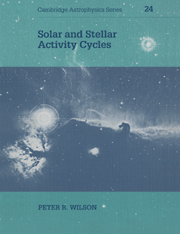Book contents
- Frontmatter
- Contents
- Preface
- Acknowledgments
- 1 Introduction
- 2 Historical survey
- 3 The structure of the Sun and the phenomena of activity
- 4 The equations of magnetohydrodynamics and magnetohydrostatics
- 5 The one-dimensional configuration of the cycle
- 6 Heuristic models of the solar activity cycle
- 7 Stellar activity and activity cycles
- 8 The two-dimensional representation of the extended activity cycle
- 9 The origin of the large-scale fields
- 10 The reversal of the polar magnetic fields
- 11 The role of dynamo theory in cyclic activity
- 12 Helioseismology and the solar cycle
- 13 Cyclic activity and chaos
- 14 Forecasting the solar cycle
- 15 Summary and conclusions
- Author index
- Subject index
14 - Forecasting the solar cycle
Published online by Cambridge University Press: 27 October 2009
- Frontmatter
- Contents
- Preface
- Acknowledgments
- 1 Introduction
- 2 Historical survey
- 3 The structure of the Sun and the phenomena of activity
- 4 The equations of magnetohydrodynamics and magnetohydrostatics
- 5 The one-dimensional configuration of the cycle
- 6 Heuristic models of the solar activity cycle
- 7 Stellar activity and activity cycles
- 8 The two-dimensional representation of the extended activity cycle
- 9 The origin of the large-scale fields
- 10 The reversal of the polar magnetic fields
- 11 The role of dynamo theory in cyclic activity
- 12 Helioseismology and the solar cycle
- 13 Cyclic activity and chaos
- 14 Forecasting the solar cycle
- 15 Summary and conclusions
- Author index
- Subject index
Summary
It's tough to make a prediction, especially about the future
Yogi BerraIntroduction
Chapter 1 discussed the relationship of the solar cycle to the terrestrial environment and offered the hope that a greater understanding of solar and stellar cycles might lead to improved predictions of the parameters of a given solar cycle and, consequently, more reliable forecasts of solar-induced geospheric phenomena.
The more important terrestrial consequences arise during and just after sunspot maximum, when the EUV-UV and total solar irradiance are also at a maximum, along with the probability of occurrence of large solar flares, particle bursts, and solar cosmic rays. These enhanced solar emissions disrupt communications, shorten the orbital lifetimes of satellites in low Earth orbit, cause failure in solid-state components in satellites, and generally introduce major or minor disruptions to our environment (see §1.3). The likelihood of the occurrence of disruptive events follows closely the intensity of the activity cycle, so that accurate forecasting of solar activity on time scales of weeks, months, and years is of considerable importance to those agencies which plan and operate space missions.
Apart from space missions, other possible terrestrial effects of the influence of solar activity are discussed in Chapter 1 and elsewhere in this book. Perhaps the most significant for us and our descendants are the small variations of the solar output which accompany the activity cycle. Although the measured variations are only a few tenths of a per cent, it is generally accepted that, because of the non-linear nature of the interaction of solar radiation with the geosphere (which is poorly understood), the effect of these small fluctuations on our environment may be considerably amplified.
- Type
- Chapter
- Information
- Solar and Stellar Activity Cycles , pp. 243 - 260Publisher: Cambridge University PressPrint publication year: 1994

